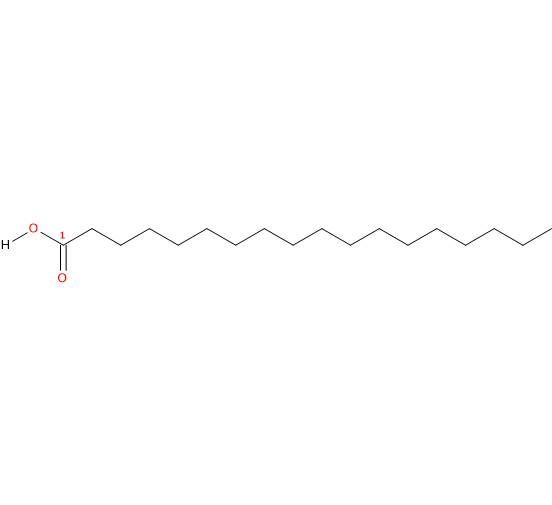iStearic acid (18 carbon atoms), from the Greek word stéar, meaning tallow (also known as beef fat), was first described by Chevreul M.E. in 1823 in the course of his researches on fats.
It belongs to the group of saturated fatty acids (no double bond, so its shorthand notation is 18:0). It is also a member of the group called long chain fatty acids (LCFA), from 14 to 18 carbon atoms.
PROPERTIES
Molecular weight: 284.47724 g/mol
Molecular formula: C18H36O2
IUPAC name: octadecanoic acid
CAS registry number: 57-11-4
PubChem: 5281

OTHER NAMES
cetylacetic acid
n-octadecanoic acid
18:0
In purified form it presents as shiny white flakes or powder, very slightly soluble in water, with melting point is at 69-70 °C (156.2-158 °F; 342.15-343.15 K) and boiling point at 383 °C (721.4 °F; 656.15 K).
It has an odor that resembles fats and oils.
Food sources of stearic acid
It occurs, as ester of glycerol, in animal and vegetable fats and oils, where is one of the most common long-chain fatty acids.
In fresh meat, white and red, it is present with a content <1.8 g/100 g of edible portion (1.79 g in goose), whereas in processed and preserved meats, such as sausages and cold cuts, it is present in larger amounts, about 3.5 g in some types of salami, but the highest concentrations are found in lard and suet, respectively, 11.1 and 16.7 g/100 g of edible portion.
In milk and milk products, it occurs in good quantities, especially in hard cheese, such as Parmesan, about 3 g/100 g of edible portion, and in butter, with 9.4 g/100 g of edible portion.
Another rich source is chicken eggs, especially the yolk, with 3.7 g/100 g of edible portion.
In fishery products, such as fish, mollusks and crustaceans, it is present in concentrations up to 1.3 g/100 g of edible portion (1.2 g in smoked eel).
It is also found in large quantities in vegetable fats and oils:
- in peanut butter and margarine, respectively, 2.8 and 5.5 g/100 g of edible portion;
- in vegetable oils, the highest amount is present in sunflower oil, 4.8 g/100 g of edible portion, but good amounts are also found in extra virgin olive oil, and coconut oil, peanut oil, rapeseed oil, corn oil, palm oil, palm kernel oil, soybean oil, sesame oil, and grape seed oil.
In fruit, the content does not exceed 1.5 g/100 g of edible portion; the highest values are observed in roasted peanuts and dried coconut, 1.28 and 1.43 g/100 g of edible portion, respectively.
In cereals and derivatives, it is present in small amounts, never higher than 2 g/100 g of edible portion (the highest content is observed in wheat germ with 1.7 g).
It is present in trace amounts in legumes (the highest content is present in chickpeas, 0.12 g/100 g of edible portion).
It is abundant in castor beans.
In the USA the principal source of stearic acid is coconut oil, and to a lesser extent, palm oil, while in third world countries are more commonly used the other plant sources.
Uses
It is used as ingredient in making candles, soaps, plastics, oil pastels, lubricant, cosmetics and as a softener in chewing gum base and for suppositories.
References
- Akoh C.C. and Min D.B. “Food lipids: chemistry, nutrition, and biotechnology” 3th ed. 2008
- Chow Ching K. “Fatty acids in foods and their health implication” 3th ed. 2008